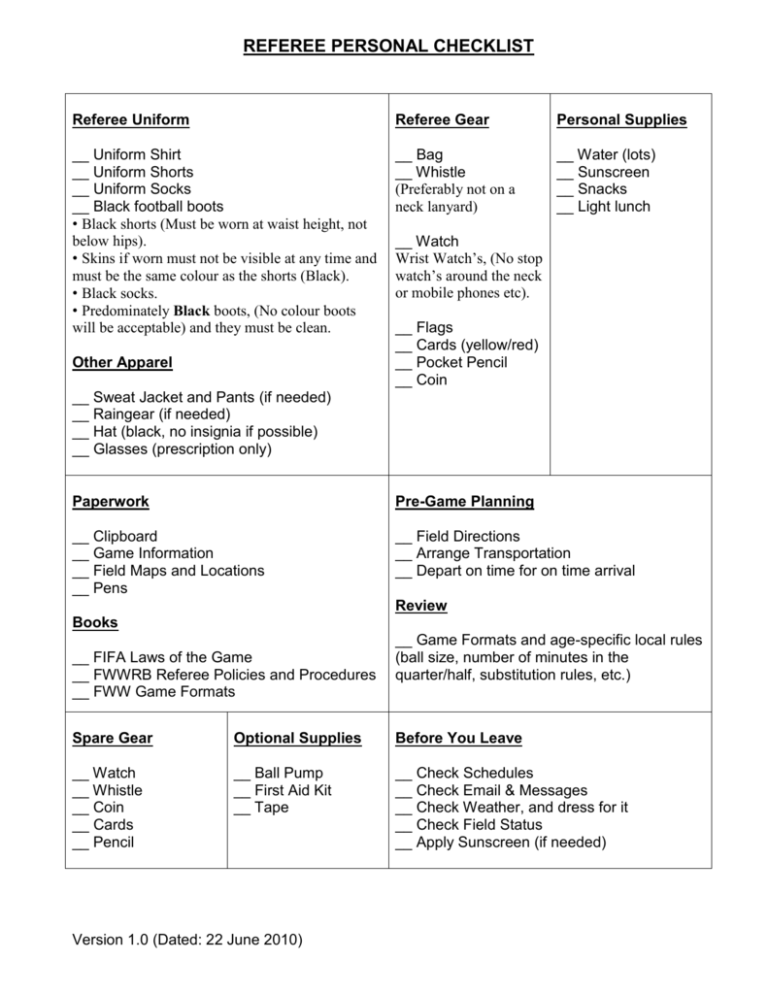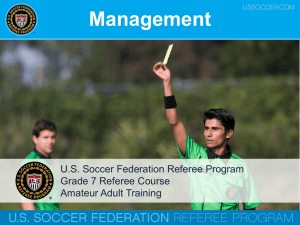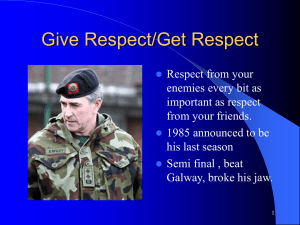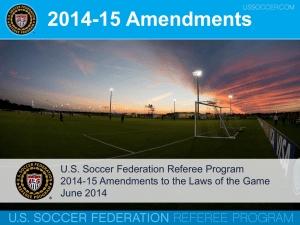FWWRB Referee`s Checklist - Wagga Football Referees Branch
advertisement

REFEREE PERSONAL CHECKLIST Referee Uniform Referee Gear Personal Supplies __ Uniform Shirt __ Uniform Shorts __ Uniform Socks __ Black football boots • Black shorts (Must be worn at waist height, not below hips). • Skins if worn must not be visible at any time and must be the same colour as the shorts (Black). • Black socks. • Predominately Black boots, (No colour boots will be acceptable) and they must be clean. __ Bag __ Whistle (Preferably not on a neck lanyard) __ Water (lots) __ Sunscreen __ Snacks __ Light lunch Other Apparel __ Watch Wrist Watch’s, (No stop watch’s around the neck or mobile phones etc). __ Flags __ Cards (yellow/red) __ Pocket Pencil __ Coin __ Sweat Jacket and Pants (if needed) __ Raingear (if needed) __ Hat (black, no insignia if possible) __ Glasses (prescription only) Paperwork Pre-Game Planning __ Clipboard __ Game Information __ Field Maps and Locations __ Pens __ Field Directions __ Arrange Transportation __ Depart on time for on time arrival Review Books __ FIFA Laws of the Game __ FWWRB Referee Policies and Procedures __ FWW Game Formats __ Game Formats and age-specific local rules (ball size, number of minutes in the quarter/half, substitution rules, etc.) Spare Gear Optional Supplies Before You Leave __ Watch __ Whistle __ Coin __ Cards __ Pencil __ Ball Pump __ First Aid Kit __ Tape __ Check Schedules __ Check Email & Messages __ Check Weather, and dress for it __ Check Field Status __ Apply Sunscreen (if needed) Version 1.0 (Dated: 22 June 2010) REFEREE AT THE GAME CHECKLIST Referee Self-Check □ □ □ □ □ □ □ □ □ □ Arrive in proper uniform with proper equipment: Referee shirt (tucked in), black shorts, black referee socks (pulled up), black shoes, whistle, watch, pen, cards, coin, flags. Proper cold weather gear (only to be worn in COLD weather): black pants, black long-sleeved shirt worn under referee shirt, black gloves, black beanie-type hat. Be at your field 30 minutes prior to the start of the game. Brief your Assistant referees of your requirements and expectations of them. Check players early enough so as not to delay the start of play. Start the game on time. Pre game Speech: ask if they have questions. Tell about anything unusual or how you will play any advantage and tell them enjoy the game. Never threaten “if you do this, I’ll do that”. Strong signals, let everyone know what you call. Loud whistle, strong arm signals, clear voice. Foul Play; bring play under control early, players will be testing to see what you let them get away with early and escalate from there. Players crash into one another? Blow the whistle. Stop fouls! Game Reports; don’t put it off, file reports the same day. Field □ □ □ □ Check that the field is marked; the goals are secured; ensure that nets are not loose or open on the sides. Check corner flags. Check field for any major debris, holes, etc. -report areas of concern to home ground official. Check field even if another game has been played before yours. Be aware of any person behind the goals and ask the home ground official to have them removed. If necessary stop play until they have gone. Coaches □ □ □ □ □ □ □ □ □ □ □ Introduce yourself and your linesmen (if you have them ask for assistance if necessary). Collect Team Sheet at least 5 minutes prior to start of game; if not the game halves are to be shortened equally so the game finishes on time. Complete and return to home team coach at end of the game. Once the game has started no further entries can be made to the team sheet. Secure the team sheet book while you are on the field, so no one can make any alterations after the game has started. Coach and or club officials are placed on the team sheet. Remind coaches to remain in the technical area. Only team officials listed on team sheet and interchange/substitute players are allowed in the technical area. Interchanges are from the halfway line interchange box. Remind coaches to stay off the field until given permission to enter. Game ball/s supplied from home team should be the correct type/size and pressure. Version 1.0 (Dated: 22 June 2010) Players □ □ □ □ □ □ All players must wear correct soccer/football boots. With no sharp studs. All players must wear shin guards, completely covered and under their socks. All players’ shirts must be tucked in at the start of the game. All players must be listed on the team sheet prior to the start of the game. Shirt numbers match the players name on the team sheet. No jewelry or hats; No sun/glasses, unless prescription, No casts! No Metal hair clips. Nothing dangerous. Game Guidance □ Entry to field All officials are to enter the field of play as a team, carrying the footballs (Not kicking, tossing or throwing the balls). □ Record Keeping All officials must keep an accurate record of the game, (This means the Assistant referees as well). □ Positioning Refer to the FFA law chart, (Positioning Concepts) page 94 & 95. □ Advantage A foul must be committed before advantage can be applied and there has to be possession and opportunity before advantage is considered and applied, otherwise a free kick should be awarded. □ Whistle Variation □ Referees need to use a short moderate whistle tone for minor offences and long loud whistle tones for more severe offences. Lack of Authority – Even minor whistle application needs to be loud enough to stop play. Over use – Referees need to use their voice and arm signals in an effort to minimise the unnecessary use of the whistle. Arm Signals Referees need to be aware that their arm signals portray an image of authority and confidence and knowledge of the laws. □ Foul Identification Referees have to realise that minor fouls and incidents can escalate very quickly and need to be managed with either a free kick or verbal support when advantage is or is not being applied. □ Dangerous Play – , E.g. lateral (Sliding) To enhance their player management techniques, the referee should penalise these incidents, and if necessary caution the player. This will send a clear message to the players that this type of play will not be tolerated. □ Caution Technique E.g. Holding cards in the face of players, cards not pulled out early enough. Card delivery should be a full arm’s length from the player and the card held high in the air. Reference – FFA 2010 Law chart, (Referee Signals) Pages 49 -51. □ Injury Players that require injury attention from a team official must leave the field of play and only go back on with the permission of the referee. The exception to this rule is the goal keeper. Version 1.0 (Dated: 22 June 2010) Assistant Referees □ Signals □ Hyper extending of the flag arm is a key issue. (This means the arm delivering the flag moves behind the shoulder) Flag angle is inconsistent. Angle should be 45 degrees. Refer to FFA Law Chart page 53. Flag only to be held with one hand at a time. Flag always in the hand closest to the referee facing the field of play. Assistant Referees need to be stationary before signaling, not running and signaling at the same time. Side Stepping Side stepping should be used when there is a concentration of players challenging for the ball with the possibility of some of those players being in an offside position. This is generally located in the defensive 3rd of the field. Correct side stepping requires the assistant referee to be square to the pitch. □ Sprinting AR’s need to keep the flag arm still when sprinting along the touch line. This is to ensure that the referee is not unnecessarily distracted by flag movement. Body position for sprinting along the touch line should be square to the goal line with the head turned at a right angle looking along the shoulder to the field of play. □ AR Positioning AR’s are required to follow the ball and or players all the way to the goal line, with no exceptions. This includes signaling for Goal and Corner kicks. Version 1.0 (Dated: 22 June 2010)



